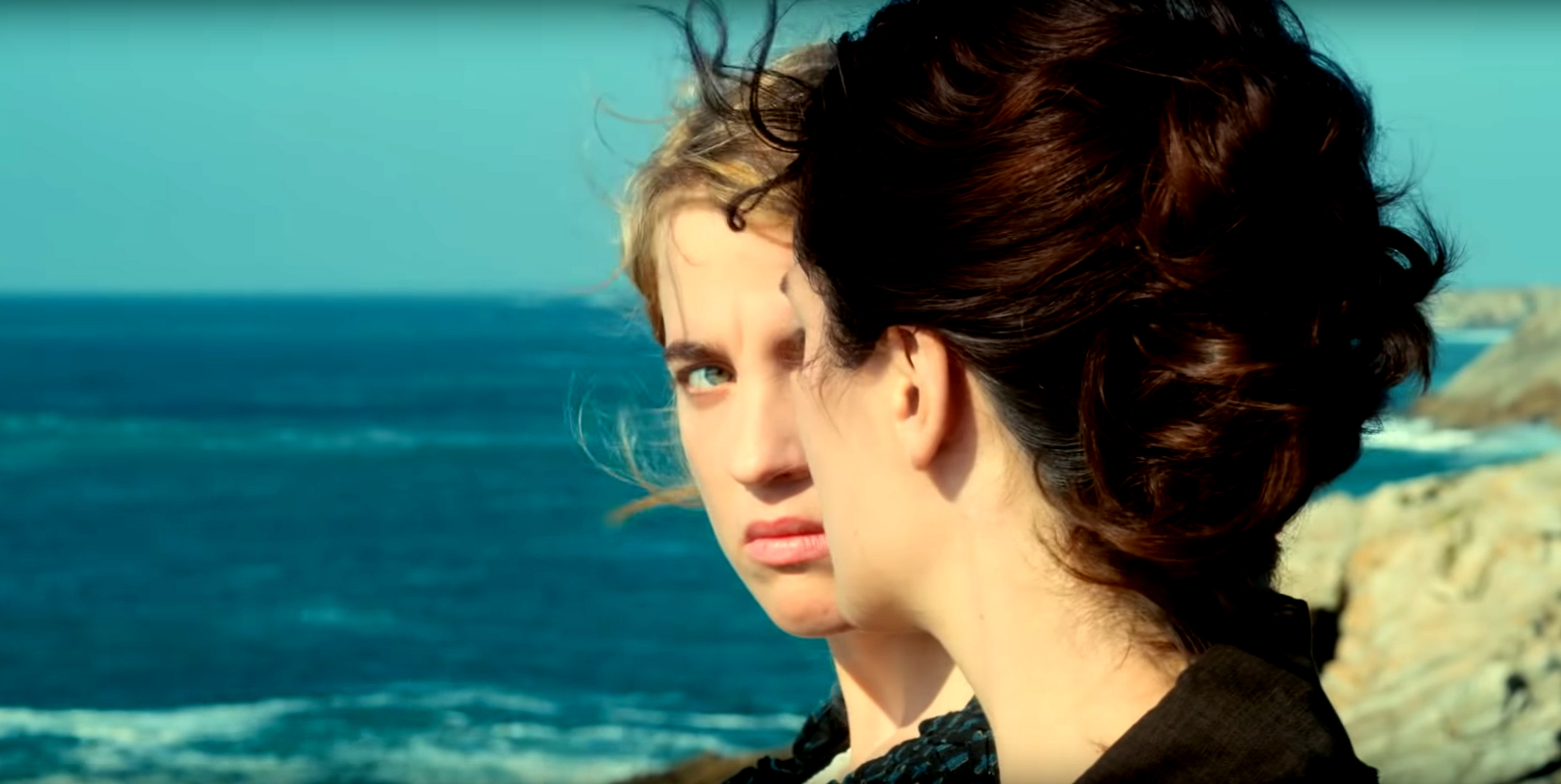Portrait Of A Lady On Fire is about truly being seen by another
"Is that how you see me?"


In his 1868 novel Norwood, or Village Life in New England, clergyman, abolitionist, and social reformer Henry Ward Beecher opines that "every artist dips his brush in his own soul and paints his own nature into his pictures." A century and a half later, French filmmaker Céline Sciamma's latest, Portrait of a Lady on Fire, incidentally dramatizes this dynamic through rigorous demonstrations of portraiture: The movie focuses on two women falling in love with each other in the late 1700s, one an aristocrat, the other an artist commissioned to capture her likeness on canvas.
Marianne (Noémie Merlant) arrives at an island castle off the coast of Brittany, soaked to the bone but no worse for wear, ready to start painting her subject, Héloïse (Adèle Haenel); the portrait is intended as a gift to Héloïse's betrothed, a Milanese nobleman who wants to know what she looks like before he commits. (Think of it as an 18th-century dating app, only much worse.) Héloïse, being strong in spirit and intolerant of suffocating misogynist baloney, has already sent the previous portrait artist packing by refusing to pose for them, so at the behest of her mother, the Countess, (Valeria Golino), Marianne plays a hired companion, palling around with Héloïse by the sea, getting existential and philosophical as the French are wont to do.
By day, Marianne watches Héloïse. By night, she paints. Sciamma's camera cuts back and forth between Merlant's face and the canvas, where the audience sees the slowly blossoming fruits of her labor. (They also see hands belonging not to Merlant but Hélène Delmaire, the French artist who shouldered the Herculean task of painting 14 versions of Héloïse's portrait as Sciamma's cinematographer, Claire Mathon, breathed down her neck.) Eventually, Marianne completes Héloïse's portrait, and they part ways under heart-wrenching circumstances. But considering that the movie has the word "portrait" in the title, finishing the portrait feels besides the point.
The Week
Escape your echo chamber. Get the facts behind the news, plus analysis from multiple perspectives.

Sign up for The Week's Free Newsletters
From our morning news briefing to a weekly Good News Newsletter, get the best of The Week delivered directly to your inbox.
From our morning news briefing to a weekly Good News Newsletter, get the best of The Week delivered directly to your inbox.
Portrait of a Lady on Fire's central feature is its love story, which is as much a story of gender politics, life as a woman under patriarchal rule, queer identity, and what it's like to truly see, and be seen by, another person as it is a visual lesson on the artist's process. Frankly, the latter is in many ways more important than the former elements; without it, the audience has less reason to appreciate the amour. Marianne thinks she can simply paint Héloïse, that all she'll need to do is observe and report, and that this is enough to reflect Héloïse's essence. For the Milanese suitor, maybe it would've been. For Marianne and for Héloïse, it's inadequate. "Is that me?" Héloïse archly inquires when she lays eyes on Marianne's work, about an hour into the film. "Is that how you see me?"
"It's not only me," Marianne replies. It's how the "rules, conventions, and ideas" that comprise the painter's discipline see Héloïse, in other words, Héloïse means that there's neither life nor presence in the work. Marianne, at this moment, has little to go on but her eyes and education to aid her in Héloïse's portrait; instead, she has to paint what she knows, and what she knows, as the audience clearly sees through sequences of Delmaire painting before Mathon's lens, is what she's been taught. Their exchange rapidly grows heated. "The fact it isn't close to me, that I can understand. But I find it sad it isn't close to you," says Héloïse, and Marianne's nostrils flare: "How do you know it isn't close to me? I didn't know you were an art critic."
Heloise's retort is far cooler: "I didn't know you were a painter."
Sciamma's dialogue, coupled with Merlant and Haenel's performances, would probably pop just as well sans the interstitial painting sequences, but they'd lack grounding. The trouble with turning a person into art is that all the training in the world can't help the artist snare the ineffable something that makes a person fascinating enough to paint to begin with; the work that goes into each brushstroke can easily be for naught without a firm grip on the subject's persona. Marianne's technique is impressive. We see it in each scrape of her charcoal as she traces Héloïse's contours on paper, and every crosshatch brush stroke she takes to recreate the vivid green hue of Héloïse's dress. These moments are filmed gently, but with Marianne's determination bursting around the edges of the frame. Visually, they're relaxing. Practically, they're demanding.
A free daily email with the biggest news stories of the day – and the best features from TheWeek.com
The more we see Marianne's (actually Delmaire's) technique in progress, the deeper she falls in love with Héloïse, so it's little wonder that after their prickly back and forth over the first portrait, Marianne mars it, much to the Countess' displeasure. But Marianne's gesture means so much to Héloïse that she agrees to pose for a second painting, and the work begins afresh, this time with more vigor, more passion — and more communication, too. "I can't make you smile," Marianne tells Héloïse during one of their sessions. "I feel I do, and then it vanishes." "Anger always comes to the fore," Héloïse says soothingly, as if in apology. "Definitely with you," Marianne quips back. Now that Héloïse knows she's being painted, Marianne no longer has to maintain a facade; now that she no longer has to maintain a facade, she's free to be playful.
Her freedom shows in her aesthetics. Practiced eyes are needed to tell if Delmaire does anything noticeably different when she paints in the second half of Portrait of a Lady on Fire compared to its first, but in the film, the final finished portrait speaks for itself — so much so that Sciamma doesn't show her viewer right away, and instead gives Marianne and Héloïse the first look. They both stare at it wearing their best poker faces, satisfied but also disinterested. Drawing and painting Héloïse led Marianne to see her; seeing her led Marianne to fall in love with her. Witnessing the act of artistic creation lets the film's audience appreciate the connection between love, desire, and especially memory.
Portrait of a Lady on Fire is presented from its opening sequence as a recollection, set in the movie's present day as Marianne instructs a classroom of young women to paint her. "Take time to look at me," she tells her students. Marianne by now knows well that portraiture is an investment in the subject; her experiences with Héloïse taught her as much. That investment is made through the marks on the canvas, through splashes of paint and pencil scratches, and Sciamma's emphasis on the method is essential for the development of 2019's most passionate on-screen romance.
Want more essential commentary and analysis like this delivered straight to your inbox? Sign up for The Week's "Today's best articles" newsletter here.
Bostonian culture journalist Andy Crump covers the movies, beer, music, and being a dad for way too many outlets, perhaps even yours: Paste Magazine, The Playlist, Mic, The Week, Hop Culture, and Inverse, plus others. You can follow him on Twitter and find his collected writing at his personal blog. He is composed of roughly 65 percent craft beer.



